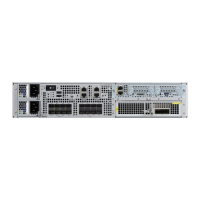10-8
Cisco ASR 1000 Series Aggregation Services Routers SIP and SPA Software Configuration Guide
OL-14127-08
Chapter 10 Configuring the Ethernet SPAs
Configuration Tasks
Use the following commands in interface configuration mode to configure QoS:
Command Purpose
Router(config-if)# plim qos input map ip
{precedence-based | precedence
precedence-value queue low-latency}
Classifies incoming IP traffic according to the
value of the IP precedence bits and places the
traffic into the appropriate queue.
• precedence-value—Specifies the value of the
IP precedence bits (0 to 7). You can specify a
range of values separated by a dash or a list of
values. By default, the Gigabit Ethernet SPA
classifies IP precedence range 6-7 as high
priority.
• low-latency—Specifies the high priority
queue. Enter 0 for low priority.
Use the no form of the command to remove the
configured values.
Router(config-if)# plim qos input map ipv6 all
queue low-latency | 0
Classifies all IPv6 packets as high or low priority.
• low-latency—Specifies high priority traffic.
Enter 0 for low priority.
The no form of this command disables all IPv6
classification By default, without using this
command, the command is disabled.
Router(config-if)# plim qos input map ipv6 tc
[tc-value | tc-range] queue low-latency | 0
Classifies ingress IPv6 traffic based on the value
of the traffic-class bits and places the traffic into
the appropriate queue.
• tc-value | tc-range—Specifies the value of the
traffic class bits. You can specify a range of
values separated by a dash or a list of values.
• low-latency—Specifies the high priority
queue. Enter 0 for the low priority queue.
The no form of this command sets the
classification according to default DSCP EF.
By default, IPv6 traffic with a traffic-class value
equal to ef uses the high-priority queue and all
other traffic uses the low-priority queue. Only the
most significant six bits of the traffic-class octet is
used for the classification.
Router(config-if)# plim qos input map mpls all
queue low-latency | 0
Classifies all MPLS packets as high or low
priority.
• low-latency—Specifies high priority packets.
Enter 0 for low priority packets.
The no form of this command disables MPLS
classification. By default, without using this
command, the command is disabled.

